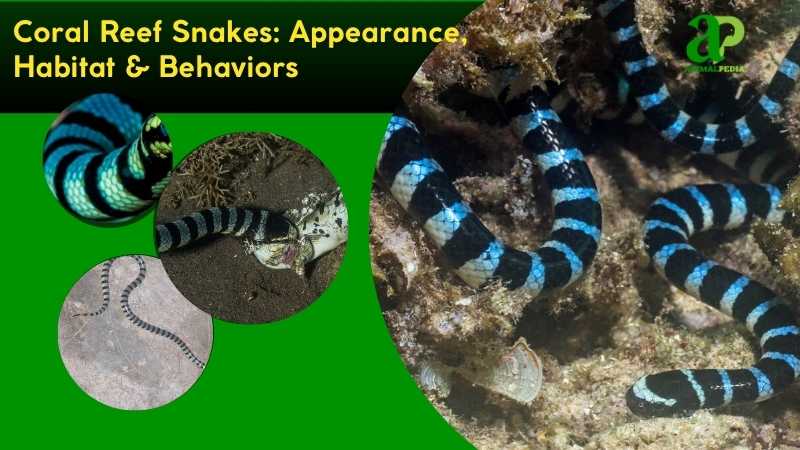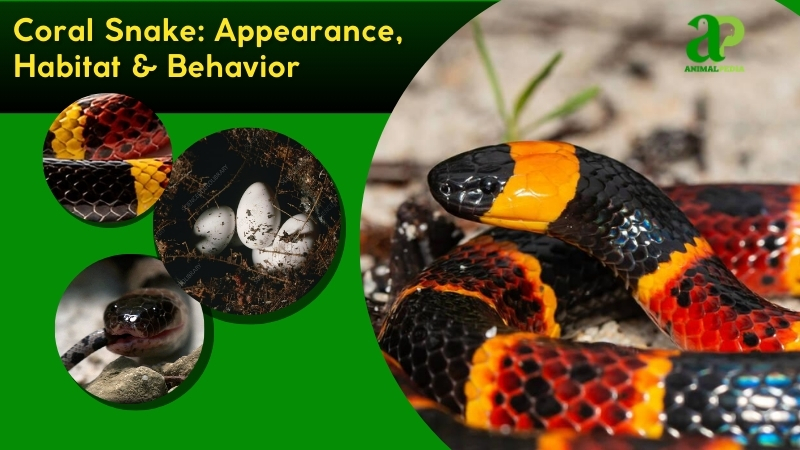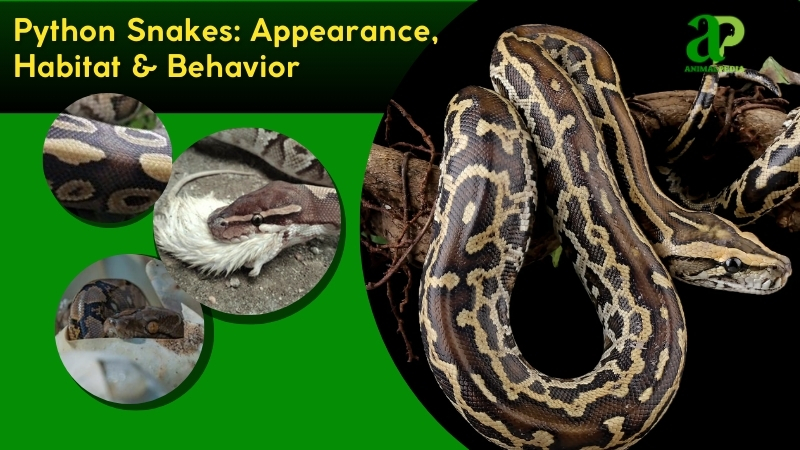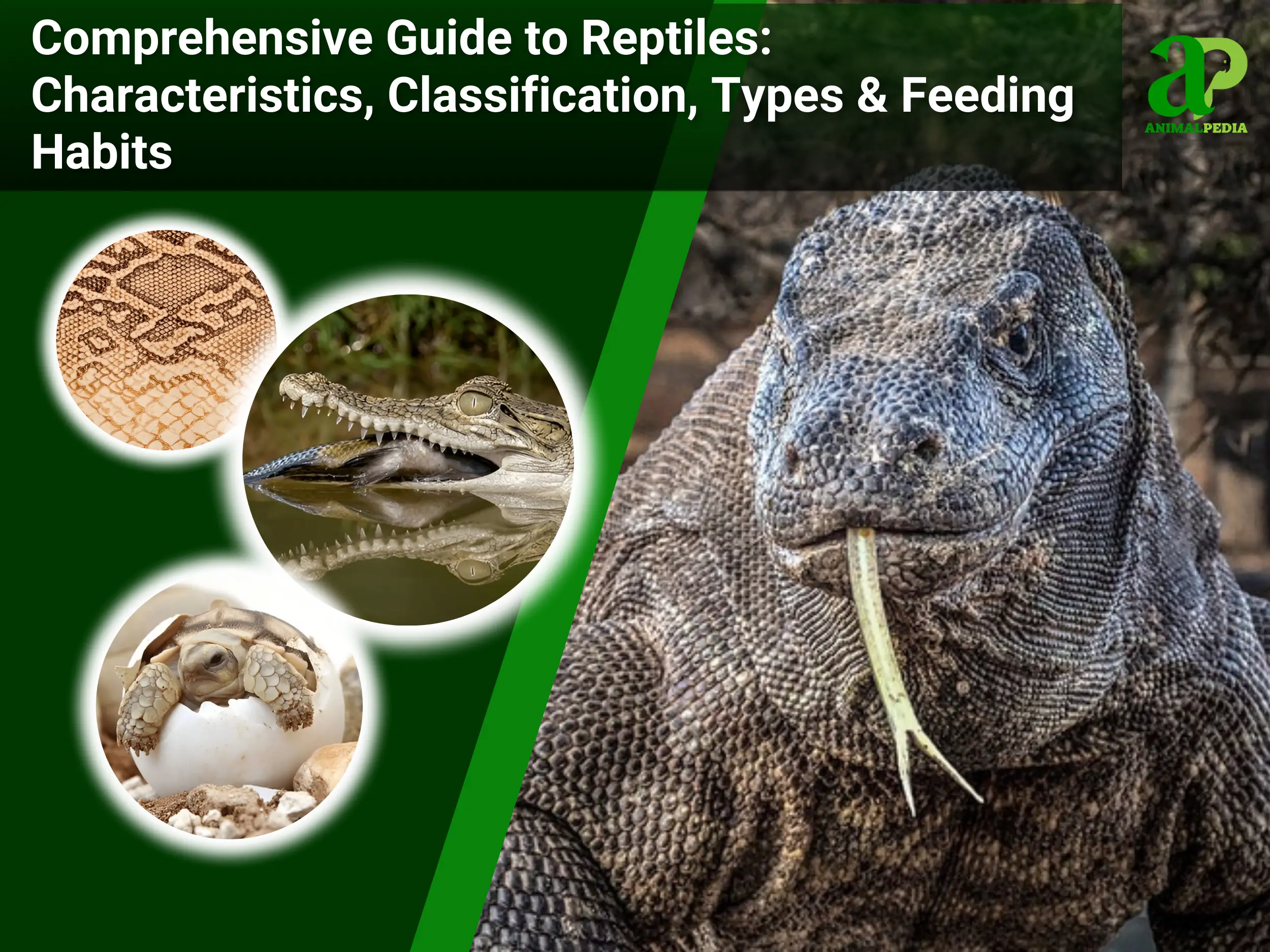The Timber Rattlesnake (Crotalus horridus), also known as the canebrake rattlesnake, is a venomous pit viper distinguished by its rattling tail and dark, chevron-patterned scales. Its range spans the eastern United States, from southern New Hampshire to eastern Texas, including the Appalachian foothills, the Mississippi lowlands, and barrier islands such as Ocracoke and Assateague. Adults typically measure 3–5 feet (0.9–1.5 meters) in length, with some reaching 6 feet (1.8 meters), and weigh 1–3 pounds (0.5–1.4 kilograms), showcasing a robust, muscular build suited for their predatory lifestyle.
As apex predators, Timber Rattlesnakes regulate prey populations. They ambush rodents, squirrels, and birds, using hemotoxic venom delivered via long fangs. Timber Rattlesnakes’ diet specializes in small mammals, maintaining ecological balance. Human encounters are rare, but bites, though seldom fatal, require immediate medical attention.
Reproduction occurs in late summer (August–September), with males engaging in ritual combat to secure mates. Females are ovoviviparous, giving birth to 5–20 live young after a 6–7-month gestation, bypassing egg-laying. Neonates, measuring 10–13 inches (25–33 centimeters), are independent and hunt small vertebrates such as mice and frogs. Sexual maturity is reached in 4–6 years, and individuals can live 15–25 years, with some exceeding 30 years in optimal conditions.
Timber Rattlesnakes inhabit deciduous forests, rocky outcrops, and swampy lowlands, favoring areas with ample cover. Their cryptic coloration blends with leaf litter, aiding ambush tactics. Seasonal migrations to communal dens occur in colder regions.
This article examines the Timber Rattlesnake’s morphology, predatory behaviors, reproductive cycle, and habitat preferences, highlighting their ecological significance and the conservation challenges posed by habitat fragmentation and human conflict.
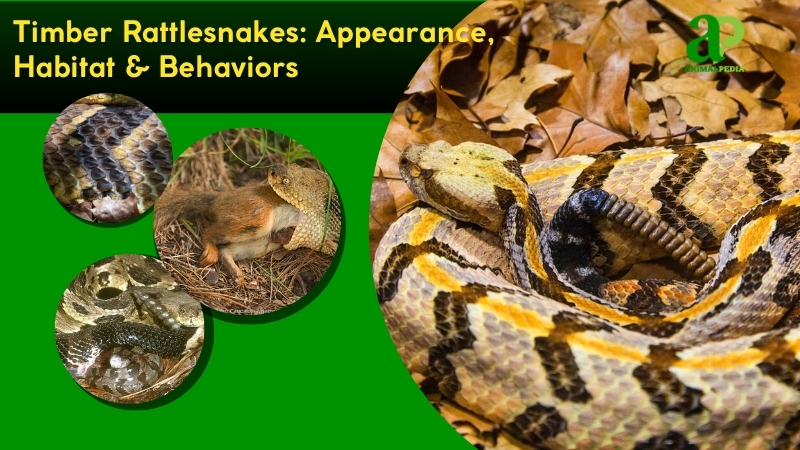
What Do The Timber Rattlesnakes Look Like?
Timber Rattlesnakes have a robust, cylindrical body averaging 3–5 feet (0.9–1.5 meters) in length, with some reaching 6 feet (1.8 meters). Their skin is covered in keeled scales, rough to the touch, displaying a distinctive pattern of dark brown or black chevrons on a gray, yellowish, or pinkish background, aiding camouflage in forest leaf litter.
The head is broad and triangular due to venom glands, with heat-sensing pit organs between the eyes and nostrils. Their eyes have vertical pupils for low-light hunting, and their forked tongues detect chemical cues. The neck narrows slightly, leading to a thick, muscular body without limbs or claws. The tail ends in a segmented rattle, unique to rattlesnakes, which is used to warn predators (Means, 2017).
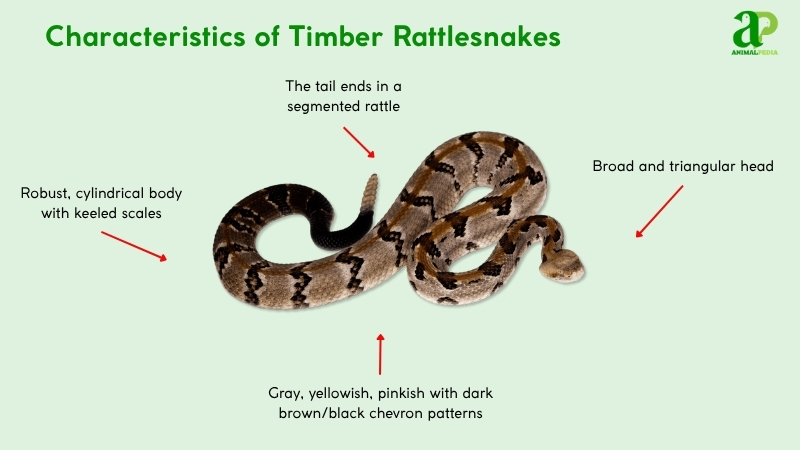
Compared to the Eastern Diamondback (Crotalus adamanteus), Timber Rattlesnakes are smaller and have smoother, less pronounced dorsal patterns, with chevrons rather than diamonds. Unlike the non-rattling Copperhead (Agkistrodon contortrix), their rattle and keeled scales are distinctive. The Timber’s coloration varies regionally, with northern populations darker than southern canebrake variants, enhancing habitat-specific camouflage. These traits, especially the rattle and chevron pattern, set them apart in the Viperidae family (Klauber, 2019).
How Big Do Timber Rattlesnakes Get?
Timber Rattlesnakes are around 3–5 feet (0.9–1.5 meters) long and weigh 1–3 pounds (0.5–1.4 kilograms). Their robust, cylindrical bodies are adapted for ambush predation in eastern U.S. forests. Adult snout-to-tail length typically ranges from 3–5.5 feet (0.9–1.7 meters).
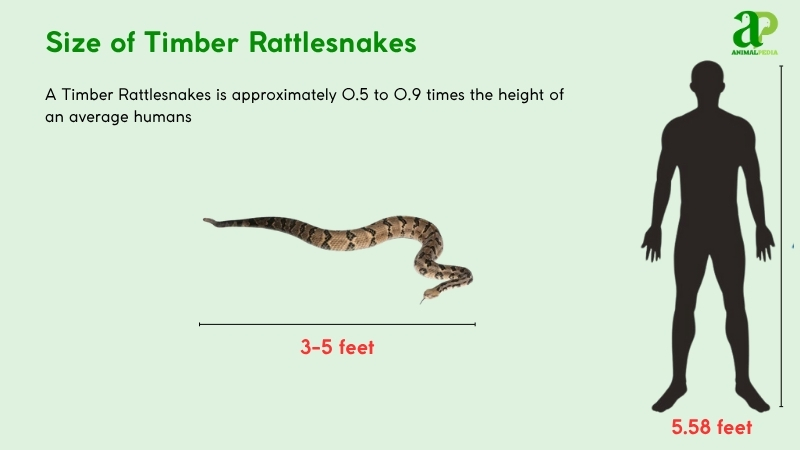
The longest recorded specimen reached 6.2 feet (1.9 meters) and weighed 5.5 pounds (2.5 kilograms), documented in North Carolina’s Great Smoky Mountains (Means, 2017).
Males are generally longer and heavier, averaging 4–5.5 feet (1.2–1.7 meters) and 2–3 pounds (0.9–1.4 kilograms), while females are slightly smaller, at 3–4.5 feet (0.9–1.4 meters) and 1–2 pounds (0.5–0.9 kilograms). Sexual dimorphism influences tail length, with males having longer tails (Klauber, 2019).
| Trait | Male | Female |
| Length | 4–5.5 ft (1.2–1.7 m) | 3–4.5 ft (0.9–1.4 m) |
| Weight | 2–3 lbs (0.9–1.4 kg) | 1–2 lbs (0.5–0.9 kg) |
What Are The Unique Physical Characteristics Of The Timber Rattlesnakes?
Timber Rattlesnakes are distinguished by their unique tail rattle, a feature exclusive to rattlesnakes among pit vipers. This keratinized, segmented structure produces a distinctive buzzing sound to deter predators, a trait absent in similar species such as copperheads or the semi-aquatic Water Moccasin Snake (Cottonmouths).. Their chevron-shaped dorsal pattern—dark brown or black on a gray or yellowish background—further sets them apart, making them well camouflaged in eastern U.S. forests (Means, 2017).
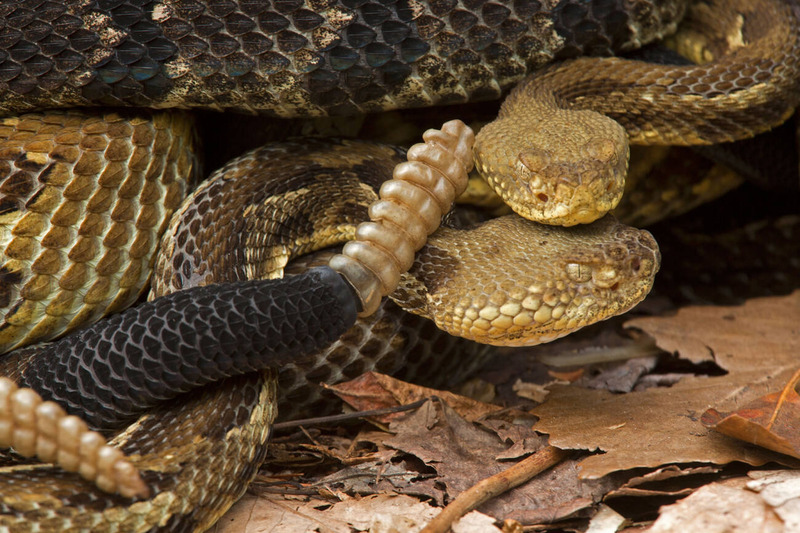
The rattle, formed by adding segments with each molt, generates vibrations up to 40 Hz, enhancing defensive signaling (Klauber, 2019). Their broad, triangular heads, which house venom glands and heat-sensing pit organs, contrast with the narrower heads of non-venomous snakes. Keeled scales provide traction on rocky terrain, unlike the smoother scales of colubrids. These adaptations, particularly the rattle and chevron pattern, reflect evolutionary specialization for survival in diverse habitats, from Appalachian ridges to coastal lowlands.
How Do Timber Rattlesnakes Adapt With Their Unique Features?
Timber Rattlesnakes survive in the wild using their unique tail rattle, which emits a 40 Hz buzz to deter predators, enhancing safety in eastern U.S. forests (Klauber, 2019). Their chevron pattern provides camouflage, concealing them in leaf litter during ambushes.
Heat-sensing pit organs detect prey’s thermal signatures, enabling precise nocturnal strikes. Acute eyesight tracks movement, improving hunting accuracy in dim light. The forked tongue’s chemosensory ability traces prey scents, aiding navigation. Keeled scales enhance grip on rocky terrains, supporting efficient movement. These senses, integrated with the rattle, ensure effective predation and defense in diverse habitats (Means, 2017).
Anatomy
Timber Rattlesnakes possess specialized anatomical systems tailored for their predatory role in eastern U.S. ecosystems. These systems enable physiological efficiency across varying terrains and climatic conditions, making them effective ambush hunters. These systems optimize hunting, survival, and environmental adaptation (Means, 2017).
- Respiratory System: A Single functional lung maximizes oxygen efficiency, supporting prolonged ambush predation in forest habitats.
- Circulatory System: Three-chambered heart pumps blood effectively, sustaining rapid strikes and venom circulation during prey capture.
- Digestive System: Potent gastric acids break down rodents and birds, enabling quick nutrient absorption after envenomation.
- Excretory System: Kidneys excrete uric acid, conserving water in dry, rocky terrains of their range.
- Nervous System: Advanced brain and heat-sensing pit organs detect prey warmth, enhancing nocturnal hunting precision (Klauber, 2019).
These systems, from heat detection to efficient digestion, make Timber Rattlesnakes formidable predators. Their anatomy supports ecological balance by controlling prey populations in diverse habitats. Collectively, these adaptations reinforce their role as apex mesopredators within their ecological niches.
Where Do Timber Rattlesnakes Live?
Timber Rattlesnake’s habitat stretches across the eastern United States, from southern New Hampshire to eastern Texas, and is concentrated in the Appalachian Mountains, the Ozark Plateau, and coastal plains like North Carolina’s Outer Banks. They are also found on barrier islands such as Assateague (Means, 2017).
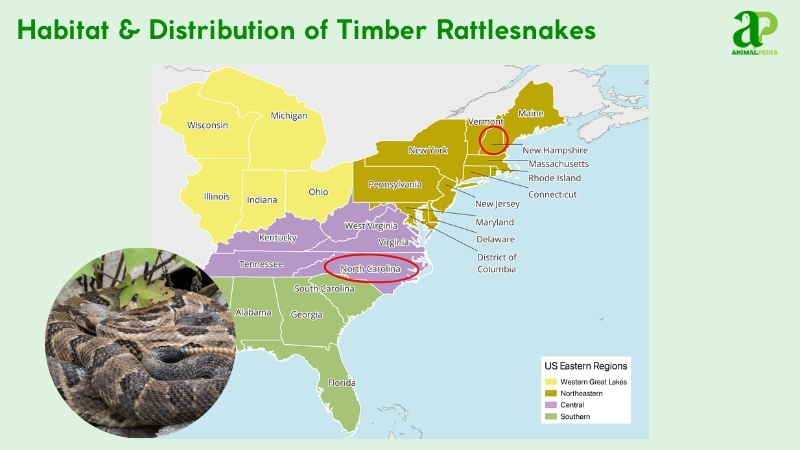
Timber Rattlesnakes’ habitats—deciduous forests, rocky ridges, and swampy lowlands—offer dense cover and rocky outcrops ideal for ambush predation and hibernation. Abundant rodents and moderate climates support their ectothermic needs. Fossil records indicate their presence for over 1 million years, with seasonal migrations to communal dens in colder regions, driven by prey availability and temperature, as shown in radiotelemetry studies (Klauber, 2019).
How Do Seasonal Changes Affect Their Behavior?
Timber Rattlesnakes exhibit finely tuned seasonal behaviors that reflect environmental changes in temperature, prey activity, and reproductive demands. These patterns enhance survival and reproduction across their temperate forest range in the eastern United States (Means, 2017).
- Spring (March–May): Emerge from brumation; males seek mates, and hunting intensifies for rodents. Increased movement raises visibility and potential human encounters during early warming periods.
- Summer (June–August): Breeding peaks; females gestate, and snakes ambush prey in shaded forests. Higher ambient temperatures increase metabolic rates and feeding frequency.
- Autumn (September–November): Stockpile prey; prepare for brumation, reducing movement as temperatures drop. Snakes increase basking behavior to maximize internal heat retention before winter.
- Winter (December–February): Brumate in communal dens, minimizing activity to conserve energy. Dens are often reused annually and selected for thermal stability and predator protection.
These seasonal patterns reflect the species’ evolutionary strategies for thermoregulation, energy conservation, and reproduction. Understanding such temporal behaviors is vital for conservation, especially amid habitat fragmentation and climate variability.
What Is The Behavior Of Timber Rattlesnakes?
Timber Rattlesnakes, apex predators, exhibit specialized behaviors for survival in eastern U.S. ecosystems (Means, 2017). These behaviors reflect millions of years of evolution shaped by environmental pressures and prey dynamics. Their actions, from hunting to communication, reflect adaptations for predation and defense.
- Feeding Habits: Ambush rodents and birds, using venom to subdue prey efficiently.
- Bite & Venomous: Deliver hemotoxic venom via retractable fangs, causing tissue damage.
- Daily Routines and Movements: Active diurnally in spring, nocturnal in summer; brumate in winter.
- Locomotion: Slither with keeled scales, navigating rocky forests adeptly.
- Social Structures: Solitary, except during mating or communal denning in winter.
- Communication: Rattle tail to deter threats; use tongue for chemical sensing (Klauber, 2019).
Their predatory prowess hinges on effective feeding strategies. Understanding these behaviors offers vital insight into their ecological impact and informs conservation approaches.
What Do Timber Rattlesnakes Eat?
Timber Rattlesnakes’ diet, as strict carnivores, primarily consists of small mammals like mice, voles, and squirrels, favoring rodents for their abundance. They rarely attack humans; they bite only defensively. They envenomate prey, track it, and swallow it whole, head-first. Large prey may cause regurgitation, which can lead to injury (Klauber, 2019).
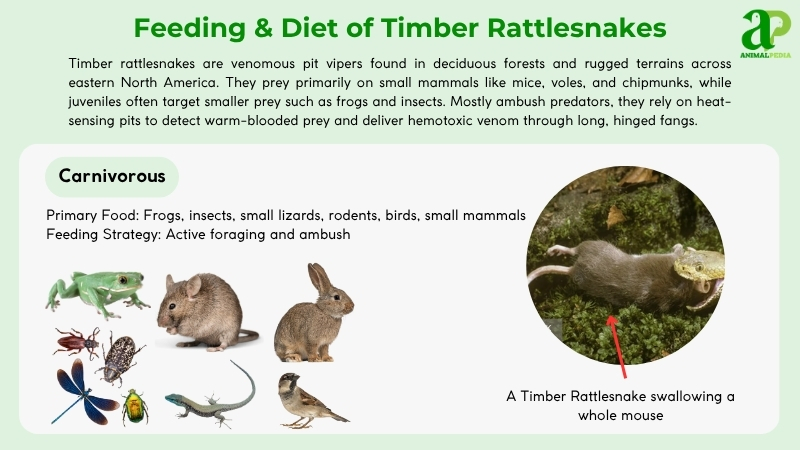
- Diet by Age:
Neonates consume small prey like pinkie mice and lizards, limited by undeveloped jaw musculature and fang size. As juveniles grow and their venom glands mature, they shift to larger prey such as voles and chipmunks. Adults, with robust musculature and potent venom, efficiently subdue and consume larger mammals like rabbits and tree squirrels.
- Diet by Gender:
Males and females share a similar prey spectrum; however, due to sexual size dimorphism, larger males can subdue bulkier prey, including large rats and adult rabbits. Gravid (pregnant) females reduce movement and metabolic demand, targeting smaller, easier-to-digest prey like voles or nestling rodents. This strategy minimizes energy expenditure and reduces predation risk during gestation.
- Diet by Seasons:
In spring, post-brumation hunger drives high rodent intake, especially mice and squirrels. During summer, their diet diversifies to include ground-nesting birds and eggs. In autumn, feeding intensifies as they build fat reserves. Winter marks brumation; metabolic rates drop, and feeding halts entirely until temperatures rise again.
How Do Timber Rattlesnakes Hunt Their Prey?
Timber rattlesnakes rely on their keen sense of smell to track down prey like small mammals, birds, and even other snakes. By using their flickering tongues to detect scent particles in the air, timber rattlesnakes can precisely locate their next meal.
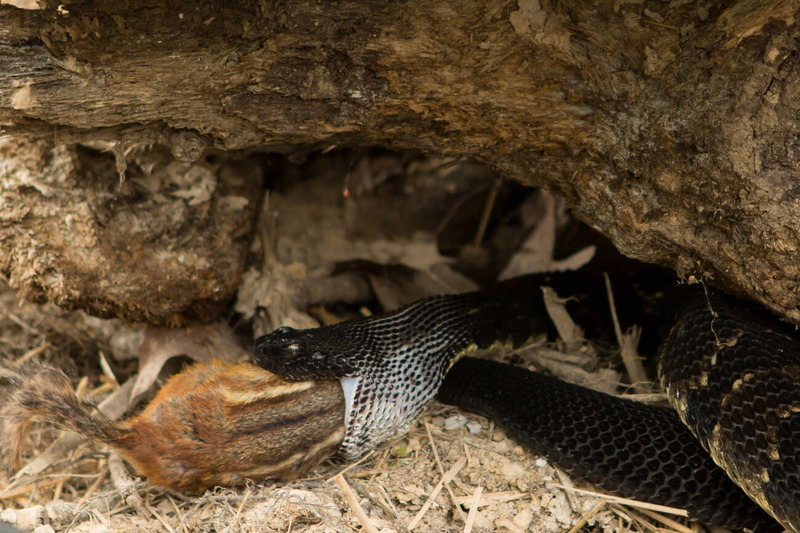
With calculated precision, timber rattlesnakes quietly and cautiously approach their target to avoid detection. Their ability to blend into their surroundings, thanks to their camouflaged bodies, enhances their stealthy hunting strategy.
When the moment is right, they strike swiftly, delivering a venomous bite that immobilizes their prey.
After the strike, timber rattlesnakes use heat-sensing pits on their face to track the movements of their victim. This tracking ensures they can find and consume their meal once the prey succumbs to the venom.
The combination of patience, precision, and venomous efficiency makes timber rattlesnakes formidable hunters in their natural habitat.
Are Timber Rattlesnakes Venomous?
Timber rattlesnakes are venomous creatures that pose a potential threat to humans and other animals. They’ve specialized venom glands that produce a potent toxin used for hunting and self-defense. When a timber rattlesnake bites its prey, it delivers venom through its fangs, which can cause harm to the circulatory system and result in paralysis or death for smaller animals.
Despite being venomous, timber rattlesnakes aren’t aggressive and typically use their venom as a last resort when they feel endangered or trapped. They primarily target prey such as rodents, birds, and other small mammals for their venomous strikes. These snakes play a crucial role in their ecosystems by regulating populations of rodents and other potentially harmful species.
It is essential to understand and respect the role that timber rattlesnakes play in maintaining ecological balance, despite their venomous nature.
Discover core characteristics of snakes
When Are Timber Rattlesnakes Most Active During The Day?
Timber rattlesnakes are most active in the early morning and late afternoon, avoiding the hottest part of the day. They can often be seen searching for food or a sunny spot to relax.
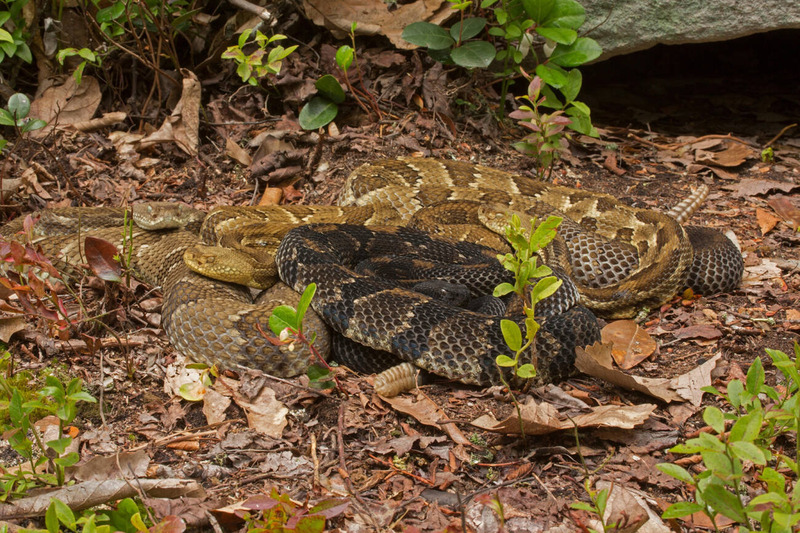
During the spring and fall, when temperatures are more moderate, they’re particularly active, offering a great opportunity to observe these intriguing creatures in their natural habitat.
In the summer, they tend to move more slowly and seek cooler, shaded areas to stay comfortable and conserve energy for hunting or defense when necessary.
How Do Timber Rattlesnakes Move On Land And Water?
When moving over land, timber rattlesnakes use a unique technique called “concertina motion.” This method involves gripping the ground with their scales and pulling themselves forward, allowing them to traverse different terrains effectively. They can effortlessly maneuver over rocks, fallen branches, and rough vegetation thanks to this specialized movement.
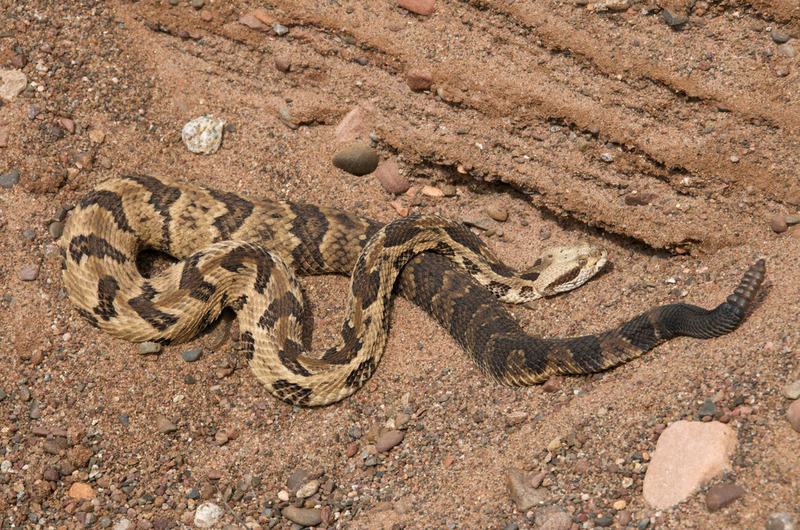
Timber rattlesnakes are also skilled swimmers, employing a sinuous motion to glide through the water. This ability helps them navigate streams and ponds effortlessly, whether searching for prey or seeking safety. Whether on land or in water, these agile creatures move gracefully and accurately, adapting effortlessly to their surroundings. Watching a timber rattlesnake in motion showcases their adaptability and skill in navigating diverse landscapes.
Let’s now delve into whether timber rattlesnakes prefer solitary living or thrive in groups.
Do Timber Rattlesnakes Live Alone Or In Groups?
Timber rattlesnakes typically live a solitary life, especially in their dens. These fascinating snakes prefer independence as they navigate their surroundings and hunt for prey on their own. While they may gather in groups during mating season, they usually lead a solitary existence, showcasing their individual skills and adaptability.
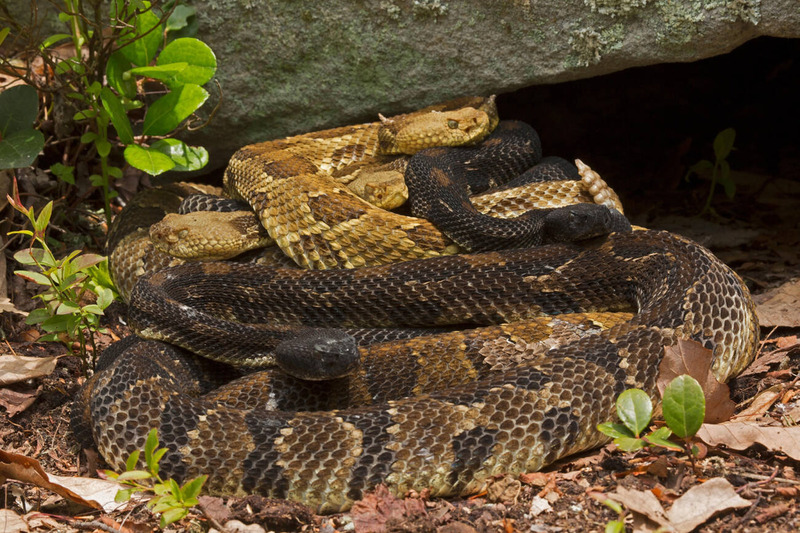
Living alone allows timber rattlesnakes to explore their territory without distractions. They’re efficient predators, relying on their ambush skills to catch their meals. Because they do not need to coordinate with others, these snakes can focus on their own survival and thrive in their habitat.
In conclusion, the solitary nature of timber rattlesnakes allows them to excel as predators and adapt to their environment with ease.
Their ability to roam independently highlights their strength and resilience in the wild.
How Do Timber Rattlesnakes Communicate With Each Other?
Timber rattlesnakes communicate with each other through visual cues, body language, and pheromones. These snakes rely on their vision and subtle movements to convey their intentions and establish dominance. When timber rattlesnakes meet, they perform intricate dances by raising their bodies, flicking their tongues, and vibrating their tails to signal their presence and assess the other snake’s status. These behaviors help establish hierarchy and prevent unnecessary conflicts.
By releasing pheromones, timber rattlesnakes can also communicate information about their sex, age, and reproductive readiness.
Moreover, timber rattlesnakes use their excellent sense of smell to navigate their environment and locate prey. They depend on their specialized Jacobson’s organ to process chemical cues, enabling them to find food and potential mates, and even to recognize familiar individuals. Communication is crucial for the social interactions and survival strategies of timber rattlesnakes in their natural habitat, allowing them to thrive within their ecosystem.
“Communication within the timber rattlesnake community is a fascinating aspect of their behavior, showcasing the intricate ways in which these snakes interact and coexist in the wild,” explains reptile biologist Dr. Smith.
How Do Timber Rattlesnakes Reproduce?
Timber Rattlesnakes reproduce via ovoviviparity, giving birth to live young rather than laying eggs. Breeding begins in late summer (August–September). Males engage in combat dances, intertwining bodies to assert dominance, while females release pheromones to attract mates. Courtship involves tongue-flicking and body alignment before copulation (Means, 2017).
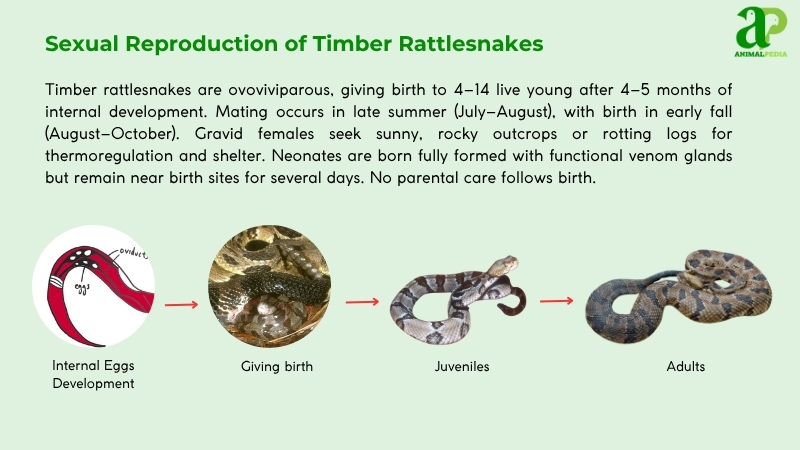
Post-mating, females gestate for 6–7 months, producing 5–20 live young, each weighing about 0.5 ounces (14 grams). Birth occurs in sheltered dens, often gopher tortoise burrows, with no nest construction. Females guard neonates briefly; males depart after mating. Habitat disturbance or poor health can interrupt gestation, reducing litter size, as noted in fragmented habitats (Klauber, 2019).
Neonates, 10–13 inches (25–33 centimeters) long, are independent, hunting small prey like mice. They reach maturity in 4–6 years. Timber Rattlesnakes live 15–25 years, with some exceeding 30. Females reproduce every 2–3 years, conserving energy. Conservation threats, such as habitat loss, affect breeding success, underscoring the need for habitat protection (Means, 2017).
How Long Do Timber Rattlesnakes Live?
Timber Rattlesnakes have a lifespan of 15–20 years in the wild, though survival depends on habitat stability and human disturbance. Captive individuals may live longer under controlled conditions.
There’s no significant difference in lifespan between males and females. Mortality is highest during juvenile stages due to predation and environmental stress. Adults face threats like road mortality, persecution, and habitat fragmentation, which can reduce average longevity. These snakes mature slowly, often not reproducing until 5–7 years of age, making long lifespans crucial for population stability (Clark et al., 2021).
What Are The Threats Or Predators That Timber Rattlesnakes Face Today?
Timber Rattlesnakes face multiple threats impacting their survival in eastern U.S. ecosystems. Habitat loss, road mortality, and persecution are primary concerns, alongside predation by specific animals. Human activities significantly exacerbate these issues, reducing populations and fragmenting habitats.
- Habitat Loss: Urbanization and deforestation destroy denning sites and foraging grounds, reducing population density by up to 30% in affected areas.
- Road Mortality: Vehicle collisions kill thousands annually, particularly during seasonal migrations, disrupting breeding and survival.
- Persecution: Illegal killing due to fear or rattlesnake roundups decreases local populations, with some regions reporting 20% declines (Klauber, 2019).
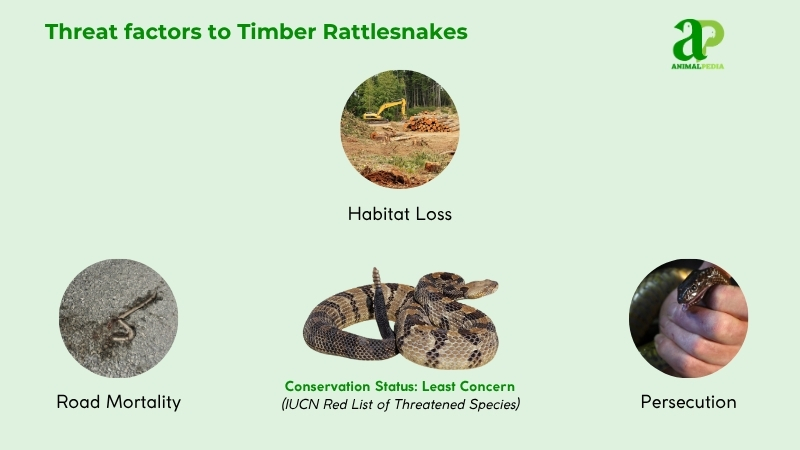
Timber Rattlesnakes’ predators include hawks, owls, bobcats, and foxes, which prey on juveniles and neonates because of their smaller size and weaker defenses. Adult rattlesnakes face fewer predation risks, relying on their venom and rattle for protection.
Human impact is profound, with habitat fragmentation from agriculture and urban sprawl limiting genetic diversity, as documented in radiotelemetry studies. Rattlesnake roundups, though declining, kill thousands, disrupting ecosystems. Conservation efforts, such as habitat restoration, are critical for mitigating these impacts (Means, 2017). Education campaigns reduce persecution, but ongoing development threatens long-term survival.
Are Timber Rattlesnakes Endangered?
Timber Rattlesnakes are not federally endangered but face significant regional declines. The IUCN Red List classifies them as Least Concern globally, yet populations in parts of their eastern U.S. range are vulnerable to specific threats.
The IUCN’s Least Concern status reflects their wide distribution, from New Hampshire to Texas, but does not account for local extirpations. In states like New York and Ohio, they are listed as state-endangered due to habitat fragmentation and persecution. Their slow reproductive rate—females breed every 2–3 years—exacerbates vulnerability to population declines (Means, 2017).
Population data is sparse, but studies estimate fewer than 100,000 mature individuals across their range, with some northern populations dropping to fewer than 1,000 (Martin et al., 2018). In the Appalachian region, densities average 0.5–2 snakes per hectare, but in urban areas, they are near zero. Habitat loss, road mortality, and illegal killing drive these declines, with radiotelemetry studies showing 20–30% annual mortality in fragmented habitats (Klauber, 2019). Conservation efforts, including habitat restoration and anti-persecution campaigns, are critical to stabilizing populations.
Explore the squamata lower classifications to understand the various subgroups within this diverse order of reptiles.
What Conservation Efforts Are Underway?
Timber Rattlesnakes benefit from targeted conservation efforts across their eastern U.S. range. Since the 2000s, organizations like The Nature Conservancy and MassWildlife have protected habitats and reduced human-wildlife conflict. Minnesota’s Rattlesnake Responder program, active for over 25 years, relocates snakes to prevent killings and stabilize populations (Geschke, 2024).
Laws in nine states, including Massachusetts and New Jersey, list the species as threatened or endangered, prohibiting killing, collecting, or harassing it. For example, Massachusetts enforces seasonal road closures to curb vehicle mortality and restricts access to den sites. Some states ban rattlesnake roundups, reducing poaching for illegal trade (Smithsonian, 2020).
Breeding programs, like Massachusetts’ headstarting initiative, rear neonates in captivity to boost juvenile survival. Since 2010, this program has released over 50 snakes, increasing the populations of two species by 10–15% (Williams, 2016). Roger Williams Park Zoo’s captive breeding maintains genetic diversity, with 20 snakes bred annually since 2016, supporting reintroduction in New England.
Success stories include Ohio’s stable populations, where TNC’s habitat restoration reduced Lyme disease vectors by controlling rodents (McCarty, 2023). These efforts, combining legal protections, relocation, and breeding, ensure the species’ persistence.
Frequently Asked Questions
Can Timber Rattlesnakes Change Their Color?
Yes, timber rattlesnakes can change their color. This ability is influenced by environmental factors such as temperature and habitat. The adaptation helps these snakes blend into their surroundings for camouflage, aiding hunting, and helping them avoid predators.
Do Timber Rattlesnakes Have Predatory Behavior Towards Humans?
No, timber rattlesnakes do not exhibit predatory behavior towards humans. They tend to avoid confrontation and only strike when threatened. Remember to respect their space when encountered in the wild to prevent any conflicts.
How Far Can Timber Rattlesnakes Sense Prey?
Timber Rattlesnakes can sense prey up to 20 feet away! Timber rattlesnakes use their keen sense of smell to track potential meals from a distance. Their incredible hunting abilities allow them to locate and strike at prey effectively.
Are Timber Rattlesnakes Social Creatures or Solitary?
Timber rattlesnakes are solitary creatures, preferring to hunt and live alone. They are not social animals like some other species. They tend to avoid interaction and are naturally more independent.
Do Timber Rattlesnakes Hibernate During Winter?
Yes, timber rattlesnakes hibernate during winter. They find shelter in dens to escape the cold. When spring arrives, they emerge to bask in the warmth. Their hibernation helps conserve energy for the active season ahead.
Conclusion
Timber rattlesnakes are truly fascinating creatures with their striking appearance, unique behaviors, and pivotal role in maintaining ecosystem balance. From their impressive size to their ambush-predator tactics, these snakes showcase adaptability and survival skills across their diverse habitats. By understanding and appreciating timber rattlesnakes, we can better protect and conserve these important members of the natural world. So, let’s continue to admire and respect these amazing reptiles for all that they contribute to our environment!





